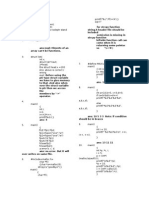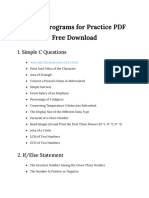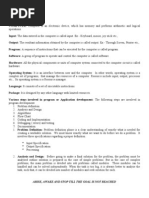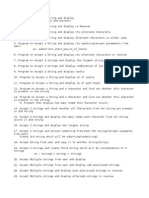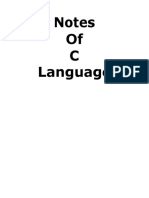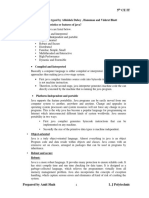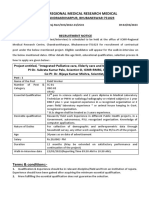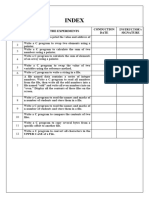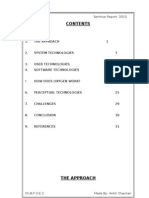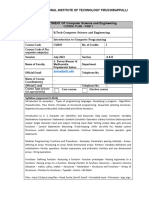C Programming Notes
Uploaded by
Ashis Kumar MohapatraC Programming Notes
Uploaded by
Ashis Kumar MohapatraC Programming
First published on 3 July 2012
This is the 7h Revised edition
Updated on:
03 August 2015
C Programming
DISCLAIMER
The data in the tutorials is supposed to be one for reference.
We have made sure that maximum errors have been
rectified. Inspite of that, we (ECTI and the authors) take no
responsibility in any errors in the data.
The programs given in the tutorials have been prepared on,
and for the IDE Microsoft Visual Studio 2013.
To use the programs on any other IDE, some changes might
be required.
The student must take note of that.
www.ecti.co.in
C Programming
History of C Programming
C Programming Language was introduced by Mr. Dennis
Ritchie in 1972. He invented this language for the internal use
of AT & T Bell Labs. But due to the features of C Programming
Language it became very popular.
Problems with languages existing before C
They were categorized in Lower Level Languages and Higher Level
Languages. The Lower Level Languages were designed to give better
machine efficiency, i.e. faster program execution. The Higher Level
Languages were designed to give better programming efficiency i.e.
faster program development.
The languages before C were Application Specific e.g. FORTRAN
(FORmula TRANslation) was built for Engineering Applications
Development, COBOL (COmmon Business Oriented Language) was
developed for Commercial Application Development.
www.ecti.co.in
C Programming
History of C Programming
Dennis Ritchie thought about giving features of both Lower
Level Languages and Higher Level Languages. So he
introduced the concept of Compilers in C. The function of
compiler is to "Convert the code from Human Readable
Language to Machine Readable Language and Vice-a-Versa".
www.ecti.co.in
C Programming
Basics of C Programming
Steps in Learning English Language:
Alphabets
Words
Sentences
Paragraph
Instructions
C Program
Steps in Learning C Language:
Alphabets
Constants
Numbers
Variables
Special Symbols
Keywords
www.ecti.co.in
C Programming
Basics of C Programming
'C' Alphabets:
A, B, , Y, Z
Alphabets
a, b, ..., y, z
Numbers
0, 1, 2, 3, 4, 5, 6, 7, 8, 9
Special Symbols
~ ' @ # % ^ & ( ) _ - + | \ { } [ ] : ; " ' <
> , . ? /
www.ecti.co.in
C Programming
Basics of C Programming
'C' Constants:
A constant is an entity that never changes. There are two type of C
Constants Primary Constants, Secondary Constants.
C Constants
Primary
Constants
Integer
Real
Character
Secondary
Constants
Array
Pointer
Structure
etc.
www.ecti.co.in
C Programming
Basics of C Programming
Rules for Constructing Integer Constants:
An Integer Constant must have at least one digit.
It must not have a decimal point.
It can be either positive or negative.
If no sign precedes an Integer Constant, it is assumed to be positive.
No commas or blanks are allowed in integer constant.
The allowable range is: -2,14,74,83,648 to 2,14,74,83,647.
Rules for Constructing Real Constants:
A Real Constant must have at least one digit.
It must have at least one decimal point.
It can be either positive or negative.
Default sign is positive.
No commas or blanks are allowed within Real Constants.
It's range is: 3.4e-38 to 3.4e38.
www.ecti.co.in
C Programming
Basics of C Programming
Rules for Constructing Character Constants:
A character constant is a single alphabet, a single digit or a
single special symbol enclosed within single inverted
commas. Both the inverted commas should point to the
left.
'C' Variables:
An entity that may vary during the program execution is
called as Variable.
Variable names are names given to the memory locations.
These locations can hold integer, real or character constants.
The integer variable needs 4 bytes, float variable needs
4 bytes, double variable needs 8 bytes and char variable
needs 1 byte memory space.
www.ecti.co.in
C Programming
Basics of C Programming
Rules for Constructing a Variable Name:
The variable name should not exceed 30 characters. Some
compilers allow variable names upto 247 characters. But
restrict variable name, as it adds to the typing effort.
The variable name can be Alpha-numeric e.g. no1
But it should start with an alphabet.
It should not contain any spaces in between.
It should not contain any special symbols except
underscore (_) in between e.g. area_circle
It should not contain any Keyword.
www.ecti.co.in
C Programming
Basics of C Programming
Keywords:
The words which are assigned with special meaning to them
in C Compiler are called as keywords. As they are assigned
with special meaning, they can not be used as variable names.
There are only 32 keywords available in C.
auto
double
int
struct
break
else
long
switch
case
enum
register
typedef
char
extern
return
union
const
float
short
unsigned
continue
for
signed
void
default
goto
sizeof
volatile
do
if
static
while
www.ecti.co.in
C Programming
Basics of C Programming
'C' Instructions:
Type Declaration Instruction: These instructions are used to
declare the type of variables used in a C Program.
int no1, no2, sum;
float radius, area;
char ch;
Arithmetic Instructions:
Arithmetic Operators
Addition
5+2=7
Subtraction
52=3
Multiplication
5 * 2 = 10
Division
5/2=2
Modulus
www.ecti.co.in
5%2=1
In normal maths, we write instruction as
follows
A+B=C
In C, we write the same as
C=A+B
In C '=' is used to assign values to
variables.
C Programming
Basics of C Programming
Priority of operators
Priority
Operators
Description
1st
()
Brackets
2nd
* / %
Multiplication, Division, Modulus
3rd
+ -
Addition, Subtraction
4th
Assignment
Control Instructions: In C Programming the execution of
program happens from top to bottom. There are certain
instruction in C which can change the flow of the program.
These instructions are called as control instructions. e.g.
while, for, goto etc.
www.ecti.co.in
C Programming
Basics of C Programming
Basic Structure of a C Program:
#include<stdio.h>
#include<conio.h>
void main()
{
.;
.;
.;
}
# preprocessor
instruction
include<x> To include a
file x to the C Program
stdio.h / conio.h Header
Files
void main() Start of a
program
{ } Scope of a Program
www.ecti.co.in
C Programming
Rules for Writing a C Program
Each Instruction in C Program is written as a separate statement.
The statements in program must appear in the same order which
we wish them to be executed, unless the logic of the program
demands a deliberate 'jump' or transfer of control to a statement,
which is out of sequence.
Blank spaces my be inserted between two words to improve the
readability of the statement.
All syntax should be entered in small case letters.
Every C statement must end with a ;. Thus ; acts as a statement
terminator.
There is no specific rule for the position at which the statement is
to be written. That's why it is often called as free-form language.
www.ecti.co.in
C Programming
First C Program
#include<stdio.h>
void main()
{
printf("This is my first C Program"); /*to print the statement*/
}
The program should be properly documented. The
statements enclosed in /* */ are called as comments.
Single line comments can also be given using //.
The program should be properly indented.
printf() is a function which prints the string embedded in
between " " on the console.
www.ecti.co.in
C Programming
Declaring & Assigning Values to Variables
#include<stdio.h>
#include<conio.h>
Note: You can assign the
values to the variables at
the time of declaration
also e.g. int no1 = 10;
%d is format specifier for
integers.
%f is format specifier for
real.
%c is format specifier for
character.
void main()
{
int no1;
float no2;
char ch;
no1 = 10;
no2 = 25.75;
ch = 'A';
printf("Integer = %d, Real = %f, Character = %c", no1, no2, ch);
getch();
/*waits for user to press any key on console*/
}
www.ecti.co.in
C Programming
scanf() Function
To receive the values from user scanf() function is used.
You can receive the single or multiple values within a single scanf.
e.g. scanf("%d", &no1) or scanf("%d%d, &no1, &no2);
Generally before any scanf() statement printf() statement should
be written to guide the user for giving input.
& means address of the variable.
#include<stdio.h>
void main()
{
int no1;
printf(\nEnter any number: ");
scanf("%d", &no1);
/*receives the value from console*/
}
www.ecti.co.in
C Programming
The Decision Control Structure
if statement
Many times we have to take actions based on certain
conditions. C provides if or if-else statement to allow you to
execute statements based on the conditions.
Before going into details of conditional statements you must
know the Relational Operators
less than
<
x<y
greater than
>
x>y
less than equal to
<=
x <= y
greater than equal to
>=
x >= y
equal to
==
x == y
not equal to
!=
x != y
www.ecti.co.in
C Programming
Forms of if-else Statements
if(condition)
..;
if(condition)
{
..;
..;
}
if(condition)
..;
else
..;
if(condition)
{
..;
..;
}
else
..;
www.ecti.co.in
if(condition)
..;
else
{
..;
..;
}
if(condition)
{
..;
..;
}
else
{
..;
..;
}
C Programming
Nested if-else Statements
if(condition)
{
if(condition)
{
..;
..;
}
else
{
..;
..;
}
}
www.ecti.co.in
else
{
if(condition)
{
..;
..;
}
else
{
..;
..;
}
}
C Programming
Logical Operators
C contains Logical
Operators && (AND), ||
(OR) and ! (NOT).
&& and || allow to join
multiple conditions.
! Operator reverses the
result of the expression it
operates on.
if(cond1 && cond2 && && condN)
{
..;
..;
}
If all the conditions joined by && are true
then the statements will be executed.
if(cond1 || cond2 || || condN)
{
..;
..;
}
If any of the conditions joined by || is true
then the statements will be executed.
if((cond1 && cond2) || (cond3 && cond4))
{
..;
..;
}
Examples
if(!flag) /*will reverse value of flag*/
{
..;
..;
}
www.ecti.co.in
C Programming
The else if Statement
void main()
{
int no1=15, no2=10, no3=8;
if (no1 > no2 && no1 > no3)
printf("The no1 is maximum");
if(no2 > no1 && no2 > no3)
printf("The no2 is maximum");
if(no3 > no1 && no3 > no2)
printf("The no3 is maximum");
getch();
}
void main()
{
int no1=15, no2=10, no3=8;
if (no1 >no2 && no1 > no3)
printf("The no1 is maximum");
else if(no2 > no1 && no2 > no3)
printf("The no2 is maximum");
else
printf("The no3 is maximum");
getch();
}
In the above example even if the first
number is maximum the other two if
statements are also checked and this
will increase the execution time of the
program.
In the above example if the fist 'if' goes
false then only second if will get
executed and if the second 'if' goes
false then the last else will get
executed.
www.ecti.co.in
C Programming
The Conditional Operators
The conditional operators ?
and : are sometimes called as
ternary operators since they
take three arguments. Their
general form is
int x, y;
scanf("%d", &x);
y = (x > 5 ? 3 : 4)
This expression will store 3 in y if x is
greater than 5 otherwise it will store 4
in y.
expression1 ? expression 2 : expression3
The above expression suggests "if
expression1 is true (that is, if it's value
is non-zero), then the value returned
will be expression2, otherwise value
returned will be expression3.
int i;
scanf("%d",&i);
If(i==1 ? printf("Amit") : printf("Rohit);
char a = 'z';
printf("%c", (a >= 'a' ? a : '!'));
int big a, b, c;
big=(a>b ? (a>c ? 3 : 4) : (b>c ? 6 : 8))
www.ecti.co.in
C Programming
The Loop Control Structure
The while loop:
In programming sometimes you want to run a block of code
repeatedly till certain number of times. The while loop helps
you to achieve this task.
The general form of while loop is
initialize the loop counter;
while(test the loop counter using a condition)
{
.........;
;
increment / decrement loop counter;
}
www.ecti.co.in
The loop counter is initialized
before going inside the loop.
If the condition is true, it will
execute all the statements
inside the loop. The counter
will be incremented or
decremented while going
outside the loop. The control
is again passed to while.
This will happen till the
condition is true.
C Programming
More Operators
++ and -- operators:
When you want to do increment
by one i.e. if you want to write
i = i + 1, you can use i++ or ++i;
Same way if you want to do
decrement by on i.e. if you want to
write i = i 1, you can use i-or --i.
There is a difference between preincrement / post-increment or predecrement / post-decrement
operators. e.g.
int i = 10, j;
j = i++;
printf(" %d %d", i, j); /* 11 10*/
www.ecti.co.in
int i = 10, j;
j = ++i;
printf(" %d %d", i, j); /* 11 11*/
In the first example the value of i is
first assigned to j and then the
value of i gets incremented.
In the second example the value of i
is first incremented and then it is
assigned to j.
Compound Assignment Operators
i=i+5
i+=5
i=i5
i-=5
i=i*5
i*=5
i=i/5
i/=5
i=i%5
i%=5
C Programming
Nesting of while loop
The way we have seen nesting
of 'if' statements, we can do
nesting of loops. Nesting of
loop means loop into another
loop. Example
*
**
***
****
In the above example, you
have to print multiple stars in
columns for each row. Such
times you need nesting of
loops.
www.ecti.co.in
void main()
{
int r = 1, c;
while(r <= 4)
{
c = 1;
while (c <= r)
{
printf("*");
c++;
}
printf("\n");
r++;
}
getch();
}
C Programming
do while Loop
The difference between while and
do while is the do while loop at
least gets executed single time.
initialize the loop counter;
do
{
...........;
;
increment / decrement loop
counter;
} while (condition);
do while loop is generally used
with odd loops. When the
programmer does not know how
many time the loop will get
executed the odd loops are used.
www.ecti.co.in
#include<stdio.h>
#include<conio.h>
void main()
{
int no1, no2, sum;
char ch;
do
{
printf("Enter 2 nos: ");
scanf("%d%d", &no1, &no2);
sum = no1 + no2;
printf("Sum = %d", sum);
printf("Want to continue <y/n>: ");
flushall();
scanf("%c", &ch);
} while(ch == 'y');
}
C Programming
for Loop
for loop specify three things
about the loop in a single line.
The general form of for
statement is as follows
for(initialize; condition; increment /
decrement)
{
..;
..;
}
e.g.
for(i = 0; i <= 10; i++)
{
printf("%d", i);
}
www.ecti.co.in
In for loop the initializations are
done only at the first time.
Then condition is checked and
while going outside the loop
the loop counter is
incremented or decremented.
You can do multiple
initializations or multiple
increments / decrements using
comma separation.
e.g.
for(i = 0, j = 5; i < j; i++, j--)
{
printf("%d %d", i, j);
}
C Programming
break, continue Statement
break statement is
used to jump out of the
loop instantly.
e.g.
for(i = 0; i <= 10; i++)
{
if(i == 5)
break;
printf("%d ", i);
}
The output of the above program
is:
01234
continue statement
takes the control of the
program to the
beginning of loop.
e.g.
for(i = 0; i <= 10; i++)
{
if(i == 5)
continue;
printf("%d ", i);
}
The output of the above program
is:
0 1 2 3 4 6 7 8 9 10
www.ecti.co.in
C Programming
The goto Keyword
goto keyword allows to
jump the program from one
location to another.
Though it is easy to use, but
it makes the program
unreliable, unreadable and
hard to debug. So avoid
using it or use it in a very
unavoidable circumstances.
The word followed by goto
keyword is called as label.
It takes the control to that
specific label.
www.ecti.co.in
void main()
{
int i;
for(i = 0; i < 10; i++)
{
if(i == 5)
goto xyz;
else
printf(" %d", i);
}
xyz:
printf("\nI am out of main");
}
The output is:
01234
I am out of main
C Programming
switch case Control Structure
The switch-case-default
allows us to make decision
from many choices.
The expression followed by
switch should be integer or
character.
The keyword case is followed
by integer or character
constants.
When user gives some choice
the switch statement takes the
control to the specified case.
If no such case exists, then
control goes to default.
Each case ends with break.
www.ecti.co.in
You cannot use logical && or
|| operators with cases.
switch(choice)
{
case 1:
..;
break;
case 2:
..;
break;
case 3:
..;
break;
default:
..;
}
C Programming
Functions
Sometimes there is a code which
occurs repeatedly inside main. To
avoid this repetition we write
functions. Functions helps to
reduce length of code.
A function is a block of code that
performs a specific assigned task.
You can call one function from
another function but you cannot
write one function's definition into
another.
The scope of the variables is
limited to the function.
Two different functions can have
variables with same name. But
their memory locations are
different.
www.ecti.co.in
#include<stdio.h>
void pune();
void mumbai();
void main()
{
printf("\nI am in main");
pune();
Call to a
function
mumbai();
printf("\nI am back in main");
getch();
}
void pune()
{
printf("\nI am in Pune");
}
void mumbai()
{
printf("\nI am in Mumbai");
}
Function
Definitions
C Programming
Functions (Passing Parameters)
In this program we
are parameters to
the function. These
functions are
called as Call by
Value functions.
#include<stdio.h>
#include<conio.h>
#include<stdio.h>
#include<conio.h>
void calsum();
void calsum(int, int);
void main()
{
calsum();
getch();
}
void calsum()
{
int no1, no2, add;
printf("\nEnter two numbers: ");
scanf("%d%d", &no1, &no2);
add = no1 + no2;
printf("\nThe sum is: %d", add);
}
void main()
{
int no1, no2;
printf("\nEnter two numbers: ");
scanf("%d%d", &no1, &no2);
calsum(no1, no2);
getch();
Actual Arguments
}
void calsum(int a, int b)
{
Formal Arguments
int add;
add = a + b;
printf("\nThe sum is: %d", add);
}
www.ecti.co.in
C Programming
Functions (Returning Value)
The function can return a
value to a calling function.
The function can return only
one value at one call.
The return statement
immediately passes control to
the calling function.
Replace void before the
function definition by int, float
or char.
There can be more than one
return statements in a function
but at a time only one will get
executed.
www.ecti.co.in
#include<stdio.h>
#include<conio.h>
int calsum(int, int);
In this program the
sum function returns
a integer value back
to main. So int is
written instead of
void
void main()
{
int no1, no2, sum;
printf("\nEnter two numbers: ");
scanf("%d%d", &no1, &no2);
sum = calsum(no1, no2);
printf("\nThe sum is: %d", sum);
getch();
}
int calsum(int a, int b)
{
int add;
add = a + b;
return add;
}
C Programming
Recursive Functions
You can give a call to a function
from the same function it is called
as recursive function.
#include<stdio.h>
#include<conio.h>
int factorial(int );
void main()
{
int no, fact;
printf("\nEnter any number: ");
scanf("%d", &no);
fact = factorial(no);
printf("\nThe factorial is: %d",
fact);
getch();
}
www.ecti.co.in
int factorial (int no)
{
int f;
if( no == 1)
return(1);
else
f = no * factorial (no 1);
return(f);
}
Make sure that the recursive
call is conditional. An
unconditional recursive call will
result to a infinite call.
C Programming
Recursive Function
from main()
factorial (int no)
{
int f;
if(no == 1)
return(1);
else
f=
no*factorial(no-1);
factorial (int no)
{
int f;
if(no == 1)
return(1);
else
f=
no*factorial(no-1);
return(f);
}
return(f);
}
to main()
www.ecti.co.in
factorial (int no)
{
int f;
if(no == 1)
return(1);
else
f=
no*factorial(no-1);
return(f);
}
C Programming
Data Types Revised
Data Type
Range
Bytes
Format
Specifiers
char
-128 to 127
%c
unsigned char
0 to 255
%c
short signed int
-32,768 to 32,767
%d
short unsigned int
0 to 65,535
%u
signed int
-32768 to 32767
%d
unsigned int
0 to 65535
%u
long signed int
-2147483648 to 2147483647
%ld
long unsigned int
0 to 4294967295
%lu
float
-3.4e38 to 3.4e38
%f
double
-1.7e308 to 1.7e308
%lf
long double
-1.7e4932 to 1.7e4932
%Lf
Note: The sizes in this figure are for 32 bit compiler
www.ecti.co.in
C Programming
C Preprocessor
There are several steps involved
from the stage of writing a C
Program to the stage of getting it
executed. The combination of
these steps is known as the 'Build
Process'.
Before the C Program is compiled
it is passed through another
program called as 'Preprocessor'.
C program is often known as
'Source Code'. The Preprocessor
works on Source Code and creates
'Expanded Source Code'. If
source file is Prog01.C, the
expanded source code is stored in
file Prog01.I. The expanded source
code is sent for compilation.
www.ecti.co.in
The preprocessor directives begin
with # symbol. Generally they are
placed at the start of the program,
before function definitions.
Following are the preprocessor
directives
Macro Expansion
Simple Macros
Macros with Arguments
File Inclusion
Conditional Compilation
Miscellaneous Directives
C Programming
C Preprocessor
Macro Expansion
Some examples -
#define PI 3.142
#define AND &&
We can use AND instead of &&
#define OR ||
We can use OR instead of ||
#define RANGE ( a > 25 && a < 50)
We can use RANGE instead of
(a>25 && a < 50)
#define FOUND printf("Location
Found");
We can use FOUND instead of
printf("Location Found")
The above expression is called as
'macro definition'. During the
preprocessing PI will be replaced
with 3.142.
PI in above example is called as
'macro template' and 3.142 is
called as 'macro expansion'.
When we compile the program,
before the source code passes to
the compiler, it is examined by C
preprocessor for macro
definitions. And when it finds the
macro templates they replace it
with appropriate macro expansion.
www.ecti.co.in
C Programming
Macros with Arguments
We can pass arguments to
macros.
#include<stdio.h>
#define AREA(x) (3.142 * x * x)
void main()
{
float r = 5.25, a;
a = AREA(r);
printf("\nThe area is : %f", a);
}
When the above code is passed to
preprocessor
a = AREA(r);
will get converted to
a = 3.142 * r * r;
www.ecti.co.in
Multiline Macros
Macros can be split into multiple lines
with a '\' (back slash) present at the
end of each line.
#include<stdio.h>
#define HLINE for(i=0; i<79; i++) \
printf("%c", 196);
#define VLINE(X, Y) { \
gotoxy(X, Y); \
printf("%c", 179); }
void main()
{
int i, y;
gotoxy(1, 12);
HLINE;
for (y = 1; y < 25; y++)
VLINE(39, y);
}
C Programming
File Inclusion
This preprocessor directive
allows us to include one file into
other.
The large programs can be
divided into different files, each
containing a set of functions.
These files can be included at
the beginning of main program
file.
The files to be included should
have .h extension. This
extension stands for a 'header
file'.
Each header file generally
contains related set of functions.
e.g. math.h will contain all functions
related to mathematics.
www.ecti.co.in
You can include these files into
main using #include
statement.
#include "filename"
#include<filename>
#include "filename" will
search filename into current
directory as well as specified
list of directories mentioned in
the include search path.
#include <filename> will
search the filename into
specified list of directories
only.
C Programming
The Build Process
C Source Code
Prog1.C
Expanded Source
Code Prog1.i
Assembly Code
Prog1.asm
Relocatable
Object Code
Object Code of
Library Functions
Linker
Executable Code
Prog1.exe
www.ecti.co.in
Preprocessing: The C code is
expanded on preprocessor directives
like #define, #include etc.
Compilation: If expanded source code
is error free then compiler translates the
expanded source code into equivalent
assembly language program.
Assembling: The job of Assembler is to
translate .asm code into relocatable
object code. Thus a .asm file gets
converted to .obj file.
Linking: Linking creates an executable
program. It finds the definitions of all
external functions, finds definitions of all
global variables, combines data sections
into a single data section and combines
code sections into single code section.
And finally .exe file is created.
C Programming
Arrays
Array is a collection of variables of
same data type.
E.g. if we want to store roll
numbers of 100 students, then
you have to define 100 variables
and which is very difficult to
manage. Instead you can define
one array which can hold 100
variables.
Declare Array:
int arr[5];
int arr[5] = {10,20,30,40,50};
int arr[ ] = {10,20,30,40,50};
When you declare an array a
consecutive memory allocation is
done for 5 integers.
www.ecti.co.in
arr
You can initialize the array only at
the time of declaration.
Array index always starts from
zero.
If you want to refer array elements
you can use arr[0], arr[1], arr[2]
etc.
In the following array 10 is a value
at array index 0 having address
6231.
Memory Map of Array:
10
20
30
40
50
6231 6235 6239 6243 6247
C Programming
Arrays
Accept and Print Array:
#include<stdio.h>
#include<conio.h>
void main()
{
int arr[5], i;
printf("\nEnter five numbers: ");
for(i = 0; i < 5; i++)
scanf("%d", &arr[i]);
printf("\nYou have entered: ");
for(i = 0; i < 5; i++)
printf(" %d", arr[i]);
getch();
}
www.ecti.co.in
As array holds multiple
locations you have to use for
loop while accepting and
printing the array.
You can define an array of
bigger size and accept the
required no. of values from
user. e.g. you can define an
array of arr[100] and use only
10 locations.
In C Language the bounds
checking for array is not done.
So the programmer has to be
very careful while accepting or
printing the values from array.
C Programming
Passing Array to a Function
#include<stdio.h>
#include<conio.h>
void display(int [ ], int);
void main()
{
int arr[5], i;
printf("\nEnter five numbers: ");
for(i = 0; i < 5; i++)
scanf("%d", &arr[i]);
display(arr, 5);
getch();
}
www.ecti.co.in
void display (int a[ ], int s)
{
int i;
printf("\nYou have entered: ");
for(i = 0; i < s; i++)
printf(" %d", a[i]);
}
C Programming
Two Dimensional Arrays
Array can have two or more
dimensions.
Declare 2D-Array:
int a[2][2];
int a[ ][2] = {10,20,30,40};
int a[ ][2] = {{10,20},{30,40}};
Memory Map of 2D-Array:
a[0][0]
a[0][1]
a[1][0]
a[1][1]
10
20
30
40
6231
6235
6239
6243
www.ecti.co.in
#include<stdio.h>
#include<conio.h>
void main()
{
int arr[3][3], i, j;
printf("\nEnter nine numbers: ");
for(i = 0; i < 3; i++)
for(j = 0; j < 3; j++)
scanf("%d", &arr[i][j]);
printf("\nYou have entered: ");
for(i = 0; i < 3; i++)
for(j = 0; j < 3; j++)
printf(" %d", arr[i][j]);
getch();
}
C Programming
Passing 2D-Array to a Function
#include<stdio.h>
#include<conio.h>
void display(int [ ][3], int, int);
void main()
{
int arr[3][3], i, j;
printf("\nEnter nine numbers: ");
for(i = 0; i < 3; i++)
for(j = 0; j < 3; j++)
scanf("%d", &arr[i][j]);
display(arr, 3, 3);
getch();
}
www.ecti.co.in
void display (int a[ ][3], int r, int c)
{
int i, j;
printf("\nYou have entered: ");
for(i = 0; i < r; i++)
for(j = 0; j < c; j++)
printf(" %d", a[i][j]);
}
C Programming
Strings
#include<stdio.h>
#include<conio.h>
String is a collection of character
variables. Sometimes you need to
store name, address where you
have to store more than one
characters, you need strings.
Declare String:
char s[50];
char s[ ] = {'P','a','r','a','g','\0'};
char s[ ] = "Parag";
Memory Map of a String:
\0
6231
6232
6233
6234
6235
6236
'\0' character is automatically
appended at the end while
accepting the string.
www.ecti.co.in
void main()
{
char name[50];
int i;
printf("\nEnter your name: ");
//scanf("%s", name);
gets(name);
printf("\nYour name is: %s", name);
printf("\nYour name is: ");
for(i = 0; name[i] != '\0'; i++)
printf("%c", name[i]);
getch();
}
C Programming
Strings
%s is special format specifier to
accept the strings. But it cannot
accept string with spaces. So use
gets(string-name) function to
accept string.
You can print the string using
puts(string-name) function.
You are not needed to accept the
size of strings as you require in
case of arrays because C
automatically appends the '\0'
character at the end of the string.
Hence you know when a '\0'
character appears, that is the end
of the string.
www.ecti.co.in
Standard Library Functions
Function
Use
strlen
Finds the length of the
string
strlwr
Converts string to
lowercase
strupr
Converts string to
uppercase
strcpy
Copies string to another
string
strcat
Appends one string at
the end of another string
strcmp
Compares two string
strrev
Reverses the string
C Programming
Passing String to Function
#include<stdio.h>
#include<conio.h>
void display(char [ ]);
void main()
{
int name[50], i;
printf("\nEnter your name: ");
gets(name);
display(name);
getch();
}
www.ecti.co.in
void display (char str[ ])
{
int i;
printf("\nYour name is: %s", str);
printf("\nYour name is: ");
for(i = 0; str[i] != '\0' ; i++)
printf("%c", str[i]);
}
Output:
Enter your name: Rohit
Your name is: Rohit
Your name is: Rohit
C Programming
Two Dimensional Strings
Strings also can have 2 or more
dimensions. When you want to
store multiple names, addresses
that time you need 2-D string.
Declare 2D-String:
char s[2][10];
char s[ ][10] = {"Parag",
"Pooja",
"Sarang"};
Memory Map of 2D-String:
6231
\0
6241
\0
6251
www.ecti.co.in
\0
#include<stdio.h>
#include<conio.h>
void main()
{
char name[3][50];
int i;
printf("\nEnter three names: ");
for(i = 0; i < 3; i++)
gets(name[i]);
printf("\nThe names are: ");
for(i = 0; i < 3; i++)
puts(name[i]);
getch();
}
C Programming
Passing 2D-String to a Function
#include<stdio.h>
#include<conio.h>
void display(char [ ][50], int);
void main()
{
char name[3][50];
int i;
printf("\nEnter three names: ");
for(i = 0; i < 3; i++)
gets(name[i]);
display(name, 3);
getch();
}
www.ecti.co.in
void display (char n[ ][50], int s)
{
int i;
printf("\nThe names are: ");
for(i = 0; i < s; i++)
puts(n[i]);
}
C Programming
Pointers
printf("\nAddress of i = %u", j);
printf("\nAddress of j = %u", &j);
printf("\nValue of j = %u", j);
printf("\nValue of i = %d", i);
printf("\nValue of i = %d", *(&i));
printf("\nValue of i = %d", *j);
getch();
Pointer is a variable which can
store address of another
variable.
& means address
* means value at that
address (except declaration)
The output of above program:
Variable name
10
Variable value
6231
Address of i =
6231
Value of i =
10
6231
Variable address
5785
Address of i= 6231
Value of i =
10
Address of j =
6233
Value of i =
10
#include<stdio.h>
void main()
{
int i = 10, *j;
j = &i;
printf("\nAddress of i = %u", &i);
www.ecti.co.in
Value of j = 6231
C Programming
Pointers
#include<stdio.h>
void main()
{
int i = 10, *j, **k;
j = &i;
k = &j;
printf("\nAddress of i = %u", &i);
printf("\nAddress of i = %u", j);
printf("\nAddress of i = %u", *k);
printf("\nAddress of j = %u", &j);
printf("\nAddress of j = %u", k);
printf("\nAddress of k = %u", &k);
printf("\nValue of j = %u", j);
printf("\nValue of k = %u, k);
printf("\nValue of i = %d", i);
printf("\nValue of i = %d", *(&i));
printf("\nValue of i = %d", *j);
printf("\nValue of i = %d", **k);
getch();
}
www.ecti.co.in
10
6231
5827
6231
5827
8989
The output of the program:
Address of
Address of
Address of
Address of
Address of
Address of
Value of j
Value of k
Value of i
Value of i
Value of i
Value of i
i
i
i
j
j
k
=
=
=
=
=
=
= 6231
= 6231
= 6231
= 6233
= 6233
=6235
6231
6233
10
10
10
10
C Programming
Call By Reference Functions
We have already seen the call by
value type of functions. The
disadvantage of call by value is
you can return only one value and
only once.
To overcome the disadvantage of
call by value we can use call by
reference type of functions.
When you pass address of a
variable to function that time the
function is called as call by
reference.
In the below example though we
have not returned the value back
to calling function, we get the
value back to sum variable due to
pointer.
www.ecti.co.in
#include<stdio.h>
#include<conio.h>
void calsum(int, int, int *);
void main()
{
int no1, no2, sum;
printf("\nEnter two numbers:");
scanf("%d%d", &no1, &no2);
calsum(no1, no2, &sum);
printf("\nSum = %d");
getch( );
}
void calsum(int x, int y, int *add)
{
*add = x + y;
}
C Programming
Passing Array to Function using Pointers
When we want to pass the array
to function using pointers we pass
it as display(arr, size) and catch
it in function using void
display(int *b, int s).
So if arr is as follows
arr
10
20
30
40
50
6231 6235 6239 6243 6247
So the base address of arr will
be stored in b. So b will hold
6231.
When you do pointer++ it will be
increased by no. of bytes of it's
datatype.
www.ecti.co.in
#include<stdio.h>
void display (int *, int);
void main()
{
int arr[5], i;
printf("\nEnter five numbers: ");
for(i = 0; i < 5; i++)
scanf("%d", &arr[i]);
display(arr, 5);
getch();
}
void display (int *b, int s)
{
int i;
printf("\nYou have entered: ");
for(i = 0; i < s; i++)
printf(" %d", *(b+i));
}
C Programming
Passing String to Function using Pointers
When we want to pass the string
to function using pointers we pass
it as display(str) and catch it in
function using
void display(char *s).
So if string is as follows
str
\0
6231
6232
6233
6234
6235
6236
So the base address of str will
be stored in s. So s will hold
6231.
There is no need to pass size of
the string as the end character of
string holds '\0';
www.ecti.co.in
#include<stdio.h>
#include<conio.h>
void display (char *);
void main()
{
char str[50];
printf("\nEnter your name: ");
gets(str);
display(str);
getch();
}
void display (char *s)
{
printf("\nYou have entered: %s", s);
printf("\nYou have entered: ");
for( ; *s != '\0'; s++)
printf("%c", *s);
}
C Programming
Structures
If we see real world data it is a
combination of integers,
characters, floats, arrays,
strings etc. So we can call it as
a heterogeneous data.
If we want to store data of a
student then we need to store
her/ his Roll Number, Name,
Address, Age, Gender, Phone
No., E-mail etc. So to store this
kind of data we can use
structures.
Structure is also called as
User Defined Datatype.
www.ecti.co.in
struct stud
{
int roll_no;
char name[20];
char gender;
};
Above syntax is used to define
a structure.
Memory Map of Structure:
stud
roll_no
name
gender
Parag Patki
50
6231
6235
6255
C Programming
Structures
#include<stdio.h>
#include<conio.h>
printf("\nEnter address: ");
flushall();
gets(s.address);
printf("\nEnter gender <y/n>: ");
flushall( );
scanf("%c", &s.gender);
printf("\nRoll No. is: %d", s.roll_no);
printf("\nName is: %s", s.name);
printf("\nAddress is: %s", s.address);
printf("\nGender is: %c", s.gender);
getch();
struct stud
{
int roll_no;
char name[50], address[100];
char gender;
};
void main()
{
struct stud s;
printf("\nEnter roll number:");
scanf("%d", &s.roll_no);
printf("\nEnter name: ");
flushall( );
gets(s.name);
www.ecti.co.in
C Programming
Nested Structures
#include<stdio.h>
#include<conio.h>
scanf("%d", &e.p.roll_no);
printf("\nEnter Name: ");
flushall( );
gets(e.p.name);
printf("\nEnter Gender <y/n>: ");
flushall( );
scanf("%c", &e.p.gender);
printf("\nEnter E-mail: ");
flushall( );
gets(e.p.email);
printf("Enter marks of three subjects:");
scanf("%d%d", &e.m1, &e.m2);
printf("\nName = %s", e.p.name);
printf("\nRoll No. = %d", e.p.roll_no);
printf("\nGender = %c", e.p.gender);
printf("\nEmail = %s", e.p.email);
printf("Marks = %d %d", e.m1, 2.m2);
getch( );
struct p_details
{
int roll_no;
char name[50];
char gender;
char email[50];
};
struct e_student
{
int m1, m2;
struct p_details p;
};
void main()
{
struct e_student e;
printf("\nEnter roll number:");
}
www.ecti.co.in
C Programming
Array of Structures
#include<stdio.h>
#include<conio.h>
for(i=0; i<size; i++)
{
printf("\nEnter roll no.:");
scanf("%d", &s[i].roll_no);
printf("\nEnter Name: ");
flushall( );
gets(s[i].name);
printf("\nEnter marks:");
scanf("%d%d", &s[i].m1, s[i].m2);
}
printf("\n\n\nRecords are:");
for(i=0; i<size; i++)
{
printf("\nRoll no.: %d", s[i].roll_no);
printf("\nName: %s", s[i].name);
printf("\nMarks:%d %d", s[i].m1, s[i].m2);
}
getch( );
struct student
{
int roll_no;
char name[50];
int m1, m2;
};
typedef struct student STUD;
void main()
{
STUD s[50];
int i, size;
printf("\nEnter no. of records: ");
scanf("%d", &size);
printf("\nEnter %d records:", size);
}
www.ecti.co.in
C Programming
Passing Structure to Function
#include<stdio.h>
#include<conio.h>
typedef struct stud
{
int roll_no;
char name[50];
int m1, m2;
}STUD;
void display(STUD);
void main( )
{
STUD s;
printf("\nEnter Roll Number: ");
scanf("%d", &s.roll_no);
printf("\nEnter Name: ");
flushall( );
gets(s.name);
www.ecti.co.in
printf("\nEnter Marks:");
scanf("%d%d", &s.m1, &s.m2);
display(s);
getch( );
}
void display(STUD s1)
{
printf("\nRoll No.: %d", s1.roll_no);
printf("\nName: %s", s1.name);
printf("\nMarks: %d %d", s1.m1, s1.m2);
}
C Programming
Passing Array of Structures to Function
#include<stdio.h>
#include<conio.h>
struct stud
{
int roll_no;
char name[50];
int m1, m2;
};
void display(struct stud[ ] );
void main( )
{
int I;
struct stud s[5];
for(i=0;i<5;i++)
{
printf("\nEnter Roll Number: ");
scanf("%d", &s[i].roll_no);
www.ecti.co.in
printf("\nEnter Name: ");
flushall( );
gets(s[i].name);
printf("\nEnter Marks:");
scanf("%d%d", &s[i].m1, &s[i].m2);
}
display(s);
getch( );
}
void display(struct stud s1[ ])
{
for(int i=0;i<5;i++)
{
printf("\nRoll No.: %d", s1[i].roll_no);
printf("\nName: %s", s1[i].name);
printf("\nMarks: %d %d", s1[i].m1, s1[i].m2);
}
}
C Programming
Structure to Pointer
#include<stdio.h>
#include<conio.h>
struct stud
{
int roll_no;
char name[50];
int m1, m2;
};
void display(struct stud *);
void main( )
{
struct stud s;
printf("\nEnter Roll Number: ");
scanf("%d", &s.roll_no);
printf("\nEnter Name: ");
flushall( );
gets(s.name);
www.ecti.co.in
printf("\nEnter Marks:");
scanf("%d%d", &s.m1, &s.m2);
display(&s);
getch( );
}
void display(struct stud *s1)
{
printf("\nRoll No.: %d", s1->roll_no);
printf("\nName: %s", s1->name);
printf("\nMarks: %d %d", s1->m1, s1->m2);
}
C Programming
Passing Array of Structures to Pointer
#include<stdio.h>
#include<conio.h>
struct stud
{
int roll_no;
char name[50];
};
void display(struct stud *, int);
void main()
{
struct stud s[3];
int i;
printf("\nEnter 3 records: \n\n");
for(i=0; i<3; i++)
{
printf("\nEnter roll no.: ");
scanf("%d", &s[i].roll_no);
printf("\nEnter Name: ");
flushall();
gets(s[i].name);
printf("\n\n");
}
www.ecti.co.in
display(s,3);
getch();
}
void display(struct stud *s1, int n)
{
int i;
printf("\nYou have entered: \n\n");
for(i=0; i<n; i++, s1++)
{
printf("\nEnter roll no.: %d", s1->roll_no);
printf("\nEnter Name: %s", s1->name);
}
}
C Programming
Input / Output in C
There are two types of I/O.
Console I/O
File I/O
Till now whatever programs we
have seen, in those programs
data vanishes when the
program ends. So to store the
data on the disk we need file
I/O operations.
All the data on the disk is
stored in binary form. But the
process of storing data varies
from OS to OS. The
programmer uses library
function in a particular OS to
perform I/O.
www.ecti.co.in
There are different operations
that can be carried out on the
file:
Creation of new file
Opening an existing file
Reading from a file
Writing to a file
Moving to a specific location in
the file
Closing a file
C Programming
Display Contents of File on Console
#include<stdio.h>
#include<conio.h>
#include<stdlib.h>
void main( )
{
FILE *fp;
char ch;
fp = fopen("Source.txt", "r");
if(fp == NULL)
{
puts("Cannot open source file");
exit(1);
}
while(1)
{
ch = fgetc(fp);
if(ch == EOF)
break;
printf("%c", ch);
}
fclose(fp);
getch();
}
www.ecti.co.in
FILE is a inbuilt structure defined in
stdio.h header file.
fopen() function searches the file on
disk to be opened, if file found it loads
it into buffer and it sets up a character
pointer that points to the first
character of buffer. If file not found it
returns NULL.
exit() function terminates the
program.
while(1) is a infinite loop.
fgetc(fp) function returns the
character present at the pointer fp
and moves the pointer to the next
location.
EOF stands for End Of File
character which indicates the end of
file.
fclose() function closes the file.
C Programming
Writing From One File to Another
#include<stdio.h>
#include<conio.h>
#include<stdlib.h>
void main( )
{
FILE *fs, *ft;
char ch;
fs = fopen("Source.txt", "r");
if(fs == NULL)
{
puts("Cannot open source file");
exit(1);
}
ft = fopen("Target.txt", "w");
if(ft == NULL)
{
puts("Cannot open target file");
fclose(fs);
exit(2);
}
www.ecti.co.in
while(1)
{
ch = fgetc(fs);
if(ch == EOF)
break;
else
fputc(ch, ft);
}
fclose(fs);
fclose(ft);
printf("File copied successfully");
getch();
fputc(ch, ft) writes the character ch to
the file location ft and moves pointer
ahead to next location.
C Programming
Writing String Received From Keyboard to File
#include<stdio.h>
#include<conio.h>
#include<string.h>
#include<stdlib.h>
void main( )
{
FILE *fp;
char s[80];
fp = fopen("Target.txt", "w");
if(fp == NULL)
{
puts("Cannot open file");
exit(1);
}
printf("\nEnter few lines: ");
while(strlen(gets(s)) > 0)
{
fputs(s, fp);
www.ecti.co.in
fputs("\n", fp);
}
fclose(fp);
printf("Data writing successful");
getch();
}
The function fputs() writes the
given string to the file. Since
fputs() does not add newline
character automatically we have
to add it explicitly.
C Programming
Reading String From File and Printing on Console
#include<stdio.h>
#include<conio.h>
#include<stdlib.h>
void main( )
{
FILE *fp;
char s[80];
fp = fopen("Target.txt", "r");
if(fp == NULL)
{
puts("Cannot open file");
exit(1);
}
printf("\nThe file data is:\n");
while(fgets (s, 79, fp) != NULL)
printf("%s", s);
fclose(fp);
getch();
}
www.ecti.co.in
The function fgets() requires
three arguments. The first is
the address where the string
is stored, the second is
maximum length of string
and the third argument is the
pointer to the structure FILE.
When all the lines from the file
have been read, fgets() returns
NULL.
C Programming
Write Records to File Using Structure
#include<stdio.h>
#include<conio.h>
#include<stdlib.h>
void main( )
{
FILE *fp;
char ch;
struct emp
{
char name[50];
int age;
float sal;
};
struct emp e;
fp = fopen("Data.txt", "w");
if(fp == NULL)
{
puts("Cannot open file");
exit(1);
}
www.ecti.co.in
do
{
printf("\nEnter name, age, sal:");
scanf("%s%d%f", e.name, &e.age, &e.sal);
fprintf(fp, "%s %d %f\n", e.name, e.age,
e.sal);
printf("\nAdd another record <y/n>: ");
fflush(stdin);
ch = getche();
}while(ch == 'y');
fclose(fp);
printf("\nData written successfully:");
getch();
}
fprintf() writes the structure to file. The first
argument is FILE pointer,
C Programming
Read Records From File Using Structure
#include<stdio.h>
#include<conio.h>
#include<stdlib.h>
void main( )
{
FILE *fp;
char ch;
struct emp
{
char name[50];
int age;
float sal;
};
struct emp e;
fp = fopen("Data.txt", "r");
if(fp == NULL)
{
puts("Cannot open file");
exit(1);
}
www.ecti.co.in
while(fscanf (fp, "%s %d %f",
e.name, &e.age, &e.sal) != EOF)
printf("\n%s %d %f", e.name,
e.age, e.sal);
fclose(fp);
getch();
}
C Programming
Writing Records Using fwrite()
#include<stdio.h>
#include<conio.h>
#include<stdlib.h>
void main( )
{
FILE *fs;
char another;
struct emp
{
char name[50];
int age;
float sal;
}e;
do
{
printf("\nEnter name, age, sal:");
scanf("%s%d%f", e.name, &e.age, &e.sal);
fwrite(&e, sizeof(e), 1, fs);
printf("\nAdd another record <y/n>?: ");
fflush(stdin);
another = getche();
}while(another == 'y');
fclose(fs);
printf("\nData written successfully to file");
getch();
}
fs = fopen("Source.txt", "wb");
if(fs == NULL)
{
puts("Cannot open source file");
exit(1);
}
www.ecti.co.in
In fwrite() function the first argument is the
address of the structure, the second argument
is size of structure in bytes, the third argument
is the number of elements to be written and the
last argument is the pointer to file where we
want to write to.
C Programming
Reading Records Using fread()
#include<stdio.h>
#include<conio.h>
#include<stdlib.h>
struct emp
{
char name[50];
int age;
float sal;
}e;
void main( )
{
FILE *fs;
fs = fopen("Source.txt", "rb");
if(fs == NULL)
{
puts("Cannot open source file");
exit(1);
}
www.ecti.co.in
while(fread (&e, sizeof(e), 1, fs) == 1)
printf("\n%s %d %f", e.name,
e.age, e.sal);
fclose(fs);
}
C Programming
Command Line Arguments
In C it is possible to accept command
line arguments. Command-line
arguments are given after the name of
a program in command-line operating
systems and are passed in to the
program from the operating system.
To use command line arguments in a
program, we first see the full
declaration of the main function, which
previously has accepted no
arguments.
void main(int argc, char *argv[])
The integer, argc is the ARGument
Count. It is the number of arguments
passed into the program from the
command line, including the name of
the program.
www.ecti.co.in
The character pointer, *argv[] is the
ARGument Values list. It has
elements specified in the previous
argument, argc.
C Programming
Command Line Arguments
#include<stdio.h>
#include<conio.h>
#include<stdlib.h>
void main( int argc, char *argv[])
{
FILE *fs, *ft;
char ch;
if(argc != 3)
{
puts("Improper no. of arguments");
getch();
exit(1);
}
fs = fopen(argv[1], "r");
if(fs == NULL)
{
puts("Cannot open source file");
getch();
exit(2);
}
www.ecti.co.in
ft = fopen(argv[2], "w");
if(ft == NULL)
{
puts("Cannot open target file");
fclose(fs);
getch();
exit(2);
}
while(!feof(fs))
{
ch = fgetc(fs);
fputc(ch, ft);
}
fclose(fs);
fclose(ft);
printf("File copied successfully");
getch();
}
Debugging an argc-argv Program
Step 1
www.ecti.co.in
C Programming
C Programming
Step 2
www.ecti.co.in
C Programming
Step 3
www.ecti.co.in
C Programming
Continued..
Execute the program and check the output.
The arguments will be taken as given by you.
NOTE: You can give strings as arguments within .
Make sure that: hi how are you, has 4 arguments whereas: hi
how are you has just 3.
www.ecti.co.in
C Programming
END OF BASICS IN C
Thus, the basics of C programming ends here.
We hope you are satisfied with the theory provided.
Feel free to share, distribute or use it in any form you wish to.
IT IS FOR YOU.
www.ecti.co.in
C Programming
END OF BASICS IN C
For advance C programming course or for any doubts in this
tutorial, please contact us on any of the following details:
Call us on: 02065000419 / 02065111419
E-mail us at: prog@ecti.co.in
Web URL: www.ecti.co.in
For any suggestions of complaints regarding the theory or
programs in the tutorial, write us at:
complaints@ecti.co.in
www.ecti.co.in
You might also like
- C in Depth (2nd Ed.) (Srivastava 2009-06-30) PDF75% (16)C in Depth (2nd Ed.) (Srivastava 2009-06-30) PDF550 pages
- Advanced C Tips and Techniques - 067248417X100% (1)Advanced C Tips and Techniques - 067248417X458 pages
- Complete C Programming Notes According To Syllbus100% (8)Complete C Programming Notes According To Syllbus39 pages
- Practical 1: Familiarization With Programming Enviroment.: Pps Lab Aayush Sharma BTPS 102-18 (1803742)50% (2)Practical 1: Familiarization With Programming Enviroment.: Pps Lab Aayush Sharma BTPS 102-18 (1803742)22 pages
- Top 100 + C Programming Interview Questions & AnswersNo ratings yetTop 100 + C Programming Interview Questions & Answers23 pages
- Questions & Answers On Control Flow Statements in CNo ratings yetQuestions & Answers On Control Flow Statements in C41 pages
- Assignment On 'C' Language Programming: Basant September 19, 2016No ratings yetAssignment On 'C' Language Programming: Basant September 19, 201620 pages
- Odisha Sub-Ordinate Staff Selection CommissionNo ratings yetOdisha Sub-Ordinate Staff Selection Commission11 pages
- M.Sc. Botany Syllabus of Centuria UniversityNo ratings yetM.Sc. Botany Syllabus of Centuria University16 pages
- Tools and Techniques of Financial AnalysisNo ratings yetTools and Techniques of Financial Analysis2 pages
- Basics of Electronics & Embedded Systems: Amit Chawla Shivam DikshitNo ratings yetBasics of Electronics & Embedded Systems: Amit Chawla Shivam Dikshit17 pages
- Practical 1:-Familiarization With Programming Environment100% (2)Practical 1:-Familiarization With Programming Environment10 pages
- Derivatives Analytics With Python Numpy PDF100% (1)Derivatives Analytics With Python Numpy PDF34 pages
- Image Inpainting Using Partial ConvolutionNo ratings yetImage Inpainting Using Partial Convolution6 pages
- CProgramming 15ME47P Polytechnic College DTE Board BengaluruNo ratings yetCProgramming 15ME47P Polytechnic College DTE Board Bengaluru38 pages
- CSIR11-Introduction-to-Computer-ProgrammingNo ratings yetCSIR11-Introduction-to-Computer-Programming6 pages
- (Ebook - ) Secrets of Borland C++ Masters PDFNo ratings yet(Ebook - ) Secrets of Borland C++ Masters PDF765 pages
- Software Developer Journal - Python Starter Kit (13 - 2013)100% (1)Software Developer Journal - Python Starter Kit (13 - 2013)89 pages
- A Companion For Fortran Programming Language: Dr. Md. Mehboob AlamNo ratings yetA Companion For Fortran Programming Language: Dr. Md. Mehboob Alam56 pages




